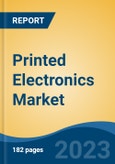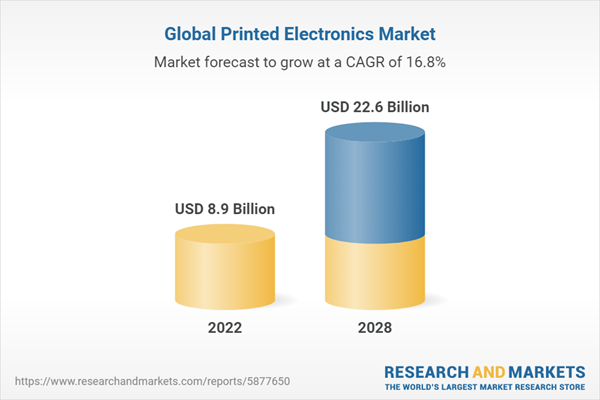Speak directly to the analyst to clarify any post sales queries you may have.
10% Free customizationThis report comes with 10% free customization, enabling you to add data that meets your specific business needs.
Printed Electronics is defined as umbrella term which is used to describe the process of printing circuits on a variety of flexible substrates to create electronic solutions. It offers a variety of printed electronic technologies with applications in industries like aerospace, medical, defence, transport, and industrial. Moreover, printed electronics offer many benefits including lightweight, inexpensive, etc.
Growing Use of Internet of Things
The blooming of Industry 4.0 has opened the wide use of Internet of things in various areas, from daily life to science, technology, and manufacturing requiring the mass production of IoT devices to meet market demands. For IoT devices, printed electronics is a good option for device fabrication due to its various advantages such as being thin, lightweight, and cost-efficient. The cost-effectiveness and rapid production time of printed electronics can quickly adapt to rapidly changing technology and consumer requirements, while its flexibility and lightness facilitate working in a variety of conditions and workspaces. Moreover, the use of flexible substrates creates the possibility to fabricate the devices using roll-to-roll (R2R) processes, which could significantly reduce the production time and cost for mass production. Moreover, products like biometric sensors, printed antennas, printed heaters, and force-sensing resistors are popular with IoT integration. Therefore, such factors are responsible for the growth of Global Printed Electronics Market.Growing Healthcare Industry
The healthcare sector has made great progress in recent years. Because various varieties of printed electronics are now in use in the global medical sector, printed electronics represent the future of health care. Flexible printed heaters, biometric sensors, and e-stimulation sensors are the three main printed electronics product categories employed in the medical industry. Biometric sensors assist in tracking patient vitals remotely in telemedicine, while printed flexible heaters are utilised in bandages to speed wound healing. Moreover, remote patient monitoring or at-home healthcare will play a pivotal role in medical care moving forward, especially with the COVID-19 pandemic still impacting societies around the world. Doctors and healthcare professionals can measure patient health vitals from remote locations, easing the stress of traveling to doctor and hospital visits, and minimizing opportunities for exposure to contagious environments because printed electronics offer solutions to release pressure from the healthcare system and increase the effectiveness of protective measures.Increase in Demand for Wearable Devices and Display Screens
Printed displays are gradually being employed for monitors, portable electronics, wearable technologies, and display screens in the consumer electronics sector. In response to the need for extremely thin and pliable displays for a variety of applications, prominent manufacturers have developed printed displays, which are made primarily utilising Organic Light-Emitting Diodes (OLED) technology. Printed electronics also operate with fewer energy and raw materials. Additionally, flexible gadgets that were previously unfeasible can now be produced using printed electronics. Printed electronics are less expensive than traditional electronics due to which its demand is expected to increase during the forecast period. Additionally, printed electronics is secure, flexible, and cost-effective, all of which make them appealing to a wide range of industries. Rise in demand for the design of large screen displays and mobile devices in developed as well as developing countries is a key factor that is estimated to boost the printed electronics industry during the forecast period. Moreover, growing investment for the development of advance printing material have fuelled the global market.Market Segments
Global Printed Electronics Market is segmented into by printing processes, material, device, and by end user. Based on printing processes, the market is segmented into screen printing, flexography, and inkjet printing. Based on material, the market is segmented into inks and substrates. Based on device, the market is segmented into displays, electronic circuits, sensors, photovoltaic, RFID, and others. Based on end user, the market is segmented into automobile, transportation, consumer electronics, healthcare, aerospace & defense, and others.Market Players
Major market players in the Global Printed Electronics Market are Samsung Electronics Co., Ltd., BASF SE, NovaCentrix, E. I. du Pont de Nemours and Company, LG Display Co., Ltd., Molex, LLC, Agfa-Gevaert Group, Palo Alto Research Center Incorporated, Nissha Co., Ltd., E Ink Holdings, Inc.Report Scope
In this report, Global Printed Electronics Market has been segmented into following categories, in addition to the industry trends which have also been detailed below:Printed Electronics Market, by Printing Processes:
- Screen Printing
- Flexography
- Inkjet Printing
Printed Electronics Market, by Material:
- Inks
- Substrates
Printed Electronics Market, by Device:
- Displays
- Electronic Circuits
- Sensors
- Photovoltaic
- RFID
- Others
Printed Electronics Market, by End User:
- Automobile
- Transportation
- Consumer Electronics
- Healthcare
- Aerospace & Defense
- Others
Printed Electronics Market, by Region:
- Asia pacific
- Europe
- North America
- Middle East & Africa
- South America
Competitive Landscape
Company Profiles: Detailed analysis of the major companies present in Global Printed Electronics Market.Available Customizations
The following customization options are available for the report:- Detailed analysis and profiling of additional market players (up to five).
This product will be delivered within 1-3 business days.
Table of Contents
Companies Mentioned
- Samsung Electronics Co. Ltd.
- BASF SE
- NovaCentrix
- E. I. du Pont de Nemours and Company
- LG Display Co. Ltd.
- Molex, LLC
- Agfa-Gevaert Group
- Palo Alto Research Center Incorporated
- Nissha Co. Ltd.
- E Ink Holdings, Inc.
Table Information
| Report Attribute | Details |
|---|---|
| No. of Pages | 182 |
| Published | September 2023 |
| Forecast Period | 2022 - 2028 |
| Estimated Market Value ( USD | $ 8.9 Billion |
| Forecasted Market Value ( USD | $ 22.6 Billion |
| Compound Annual Growth Rate | 16.8% |
| Regions Covered | Global |
| No. of Companies Mentioned | 10 |









